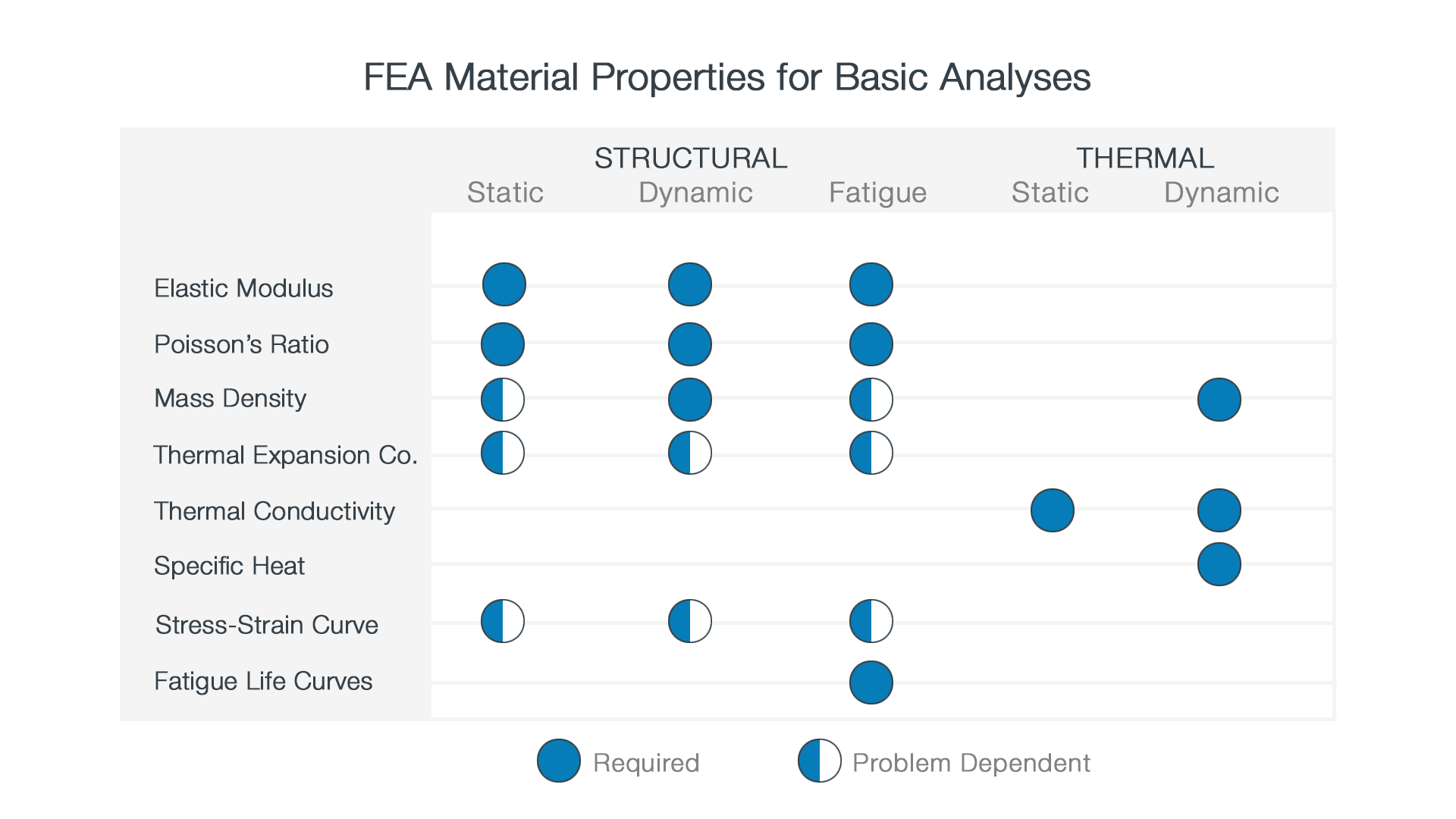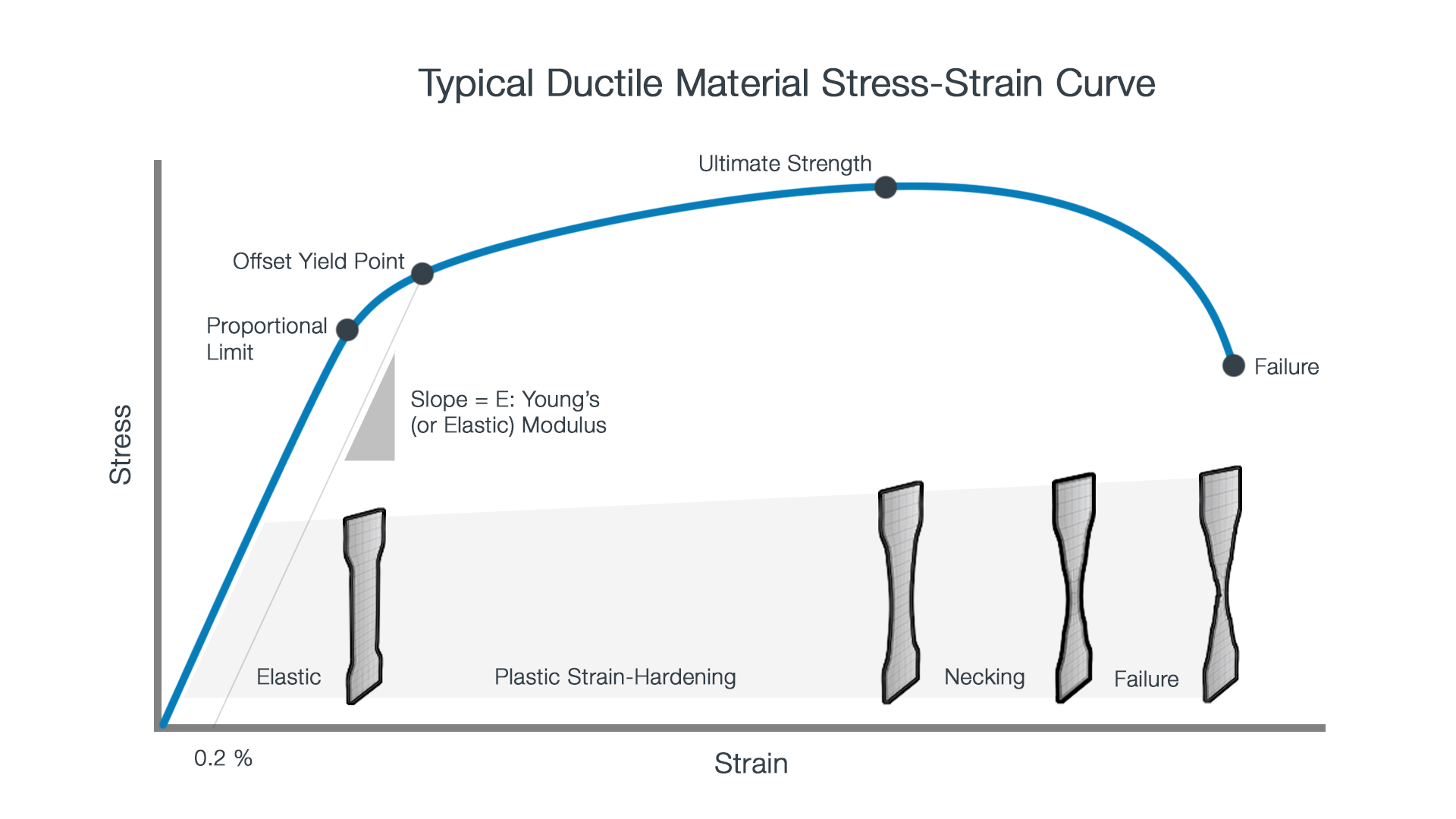Generating accurate results from Finite Element Analysis (FEA) is very dependent on having an accurate understanding of the problem being solved, component geometry, system boundary conditions, applied loadings, and FEA material properties. The behavior of solid objects subjected to stresses and strains is generally called the field of strength of materials, where stress is defined as force per unit area and strain is unitized deformation. Material properties must be derived from testing, using facilities such as Kinetic Vision's full-service Materials and Component Test Lab. Examples of the required FEA material properties for basic simulation types are shown in the figure below.

FEA Material Properties: The Stress-Strain Curve
The relationship between mechanical stress and strain for a given material is called its stress-strain curve. Isotropic materials such as most metals and unfilled plastics exhibit the same behavior in all orientations, whereas anisotropic materials, such as glass-filled plastics, composites, crystalline structures, etc. have mechanical properties that vary depending on the material orientation to the applied force. Stress-strain relationships vary greatly by material type, as metals, plastics, elastomers, glass, composites, etc. all have dramatically different behaviors. Much credit is given to Thomas Young as being the founder of the material stress-strain relationships, but tests by Giordano Riccati actually predated his work by 25 years.
Most well known are the tensile stress-strain relationships for ductile metals. Often these materials exhibit a region of linear behavior (the slope of which is called the Elastic (or Young's) Modulus, followed by a region of inelastic (plastic) deformation to a maximum load, and ultimately "necking" of the test sample and failure. A material's transverse expansion or contraction due to an axial compressive or tensile load is characterized as Poisson's Ratio, which is near 0.3 for many metals and 0.5 for incompressible materials like rubber. The figure below depicts a generalized stress-strain curve for isotropic ductile materials and highlights some important regions of interest.

FEA Material Properties: Possible Sources of Error
Unfortunately all materials behave differently depending on their temperature, strain magnitude and strain rate. In addition, published data is usually based on small samples sizes and with little variability in test specimen manufacturing. These issues are particularly prevalent in plastics and elastomers, where use temperature, small variations in processing, and application strain rate can dramatically vary a product's performance. For example, a plastic housing designed to withstand a drop test might fail because the FEA analyst utilized a static stress-strain curve instead of one that better represents the impact strain rate. The actual test result examples below show how material property-induced simulation errors might occur due to differences between published manufacturer data and actual as-received material test results, and strain rate variance for a single plastic material.

FEA Material Properties: Material Model Development
Material model development and validation is the process of understanding simulation material models and is a prerequisite for accurate simulation output and results conclusions. Our finite element analysis validation team is well versed with the development and implementation of complex FEA material models such as plastics, composites, and fabrics, and these models can be corroborated through testing in our in-house lab. Our complete Simulation Validation services ensure that your engineering analyses more accurately predict product or component performance even for the most challenging Modeling and Simulation problems.
The Kinetic Vision Materials and Component Test Lab includes electric-driven dynamic tensile and compression testing with environmental chamber for calculation of material mechanical and thermal properties. Drop, impact, vibration and other transient events can be studied using our in-house high speed video capture system. In addition to standard tension/compression testing, 3D CT Scanning allows for visualization and measurement of macro and microscopic parts, part features and components, even while they are functioning.

